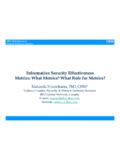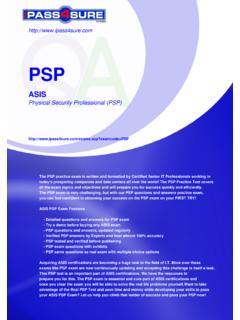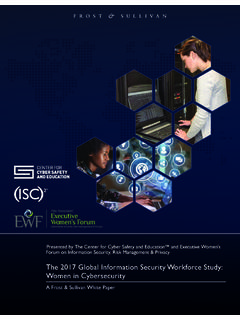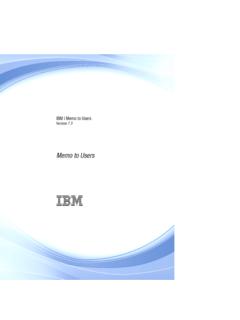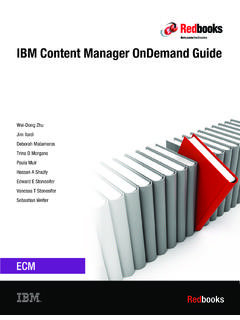Transcription of Peter Eeles peter.eeles@uk.ibm - Architecting
1 IBM Software Group IBM Software Group Non-Functional RequirementsPeter Software Group | Rational softwareIBM Software Group | Rational softwareAgenda Definitions Types of requirement Classifying requirements Capturing NFRs SummaryIBM Software Group | Rational softwareIBM Software Group | Rational softwareDefinitions Functional Requirement Functional requirements describe the behaviors (functions or services) of the system that support user goals, tasks or activities. [Malan] Non-Functional Requirement Non-functional requirements include constraints and qualities. [Malan] [System] qualities are properties or characteristics of the system that its stakeholders care about and hence will affect their degree of satisfaction with the system. [Malan] A constraint is a restriction on the degree of freedom we have in providing a solution.
2 [Leffingwell][Leffingwell] Managing Software Requirements a Unified Approach, Dean Leffingwell and Don Widrig.[Malan] Defining Non-Functional Requirements, Ruth Malan and Dana Software Group | Rational softwareIBM Software Group | Rational softwareAgenda Definitions Types of requirement Classifying requirements Capturing NFRs SummaryIBM Software Group | Rational softwareIBM Software Group | Rational softwareTypes of Requirement Use Cases Defines the behavior of the system from an external perspective System-Wide Requirements Legal and regulatory requirements, application standards, qualities that the system exhibits (such as usability, reliability, scalability, performance), operating system and environment requirements, compatibility requirements, and other design and implementation constraints Change Cases Likely future changes to either the system, in terms of its capabilities and properties, or its environment.
3 Although such changes may not be accommodated in the initial release of the system, they may impact future releases, and therefore the architectureIBM Software Group | Rational softwareIBM Software Group | Rational softwareExamples of Requirements The product will support multiple human languages The persistence will be handled by a relational database The database will be Oracle 8i The system will run 7 days a week, 24 hours a day An online help system is required All presentation logic will be written in Visual BasicIBM Software Group | Rational softwareIBM Software Group | Rational softwareAgenda Definitions Types of requirement Classifying requirements Capturing NFRs SummaryIBM Software Group | Rational softwareIBM Software Group | Rational softwareClassifying Requirements FURPS Functionality Usability Reliability Performance Supportability + Design requirements Implementation requirements Interface requirements Physical requirementsFunctional requirementsFunctional requirementsFunctional requirementsNon-functional requirementsNonNon--functional requirementsfunctional requirements*The FURPS classification was devised by Robert Grady at Hewlett-PackardIBM Software Group | Rational softwareIBM Software Group | Rational software
4 FURPS+ - Functionality All functional requirements Usually represent main product features Order Processing requirements Can also be architecturally significant Auditing, Licensing, Localization, Mail, Online help, Printing, Reporting, Security, System management, WorkflowIBM Software Group | Rational softwareIBM Software Group | Rational software FURPS+ Usability User interface issues such as accessibility, aesthetics and consistency Reliability Availability, accuracy, recoverability Performance Throughput, response time, recovery time, start-up time Supportability Testability, adaptability, maintainability, compatibility, configurability, installability, scalability and localizabilityIBM Software Group | Rational softwareIBM Software Group | Rational software FURPS+ Design requirement Constrains the design a relational database is required Implementation requirement Constrains the coding or construction required standards, platform or implementation language Interface requirement A requirement to interact with an external item Physical requirement A physical constraint imposed on the hardware used to house the system.
5 For example, shape, size and weightIBM Software Group | Rational softwareIBM Software Group | Rational softwareClassifying Requirements The product will support multiple human languages is a supportability requirement The persistence will be handled by a relational database is a design requirement The database will be Oracle 8i is an implementation requirement The system will run 7 days a week, 24 hours a day is a reliability requirement An online help system is required is a functional requirement All presentation logic will be written in Visual Basic is an implementation requirementIBM Software Group | Rational softwareIBM Software Group | Rational softwareAgenda Definitions Types of requirement Classifying requirements Capturing NFRs SummaryIBM Software Group | Rational softwareIBM Software Group | Rational softwareArchitectural mechanismsDesignMechanismImplementationM echanismPersistenceRDBMSOODBMSO racleIngresObjectStoreAnalysisMechanismC ommunicationObject RequestBrokerMessage QueueOrbixVisiBrokerMSMQMQS eriesIBM Software Group | Rational softwareIBM Software Group | Rational softwareAnalysis mechanisms Auditing Communication Debugging Error management Event management File management Graphics Information
6 Exchange Licensing Localization Mail Mega-data Memory management Meta-data Online help Persistence Printing Process management Reporting Resource management Scheduling Security System management Time Transaction management WorkflowIBM Software Group | Rational softwareIBM Software Group | Rational softwareRequirements and mechanismsFURPS requirementsRequirementsAnalysismechanis msinfluenceDesignmechanismsare refined intoDesignrequirementsinfluenceImplement ationmechanismsare refined intoImplementationrequirementsinfluenceA nalysisAnalysisDesignImplementationIBM Software Group | Rational softwareIBM Software Group | Rational softwareThe NFR dichotomy NFRs are difficult to gather Domain-specific requirements typically more visible NFRs are unfamiliar to stakeholders Few techniques for gathering NFRs Yet NFRs drive the foundations of our system (the architecture) Often relevant in a system-wide context Can be more significant than domain-specific requirements Consider the availability ( up time ) of a life support machineIBM Software Group | Rational softwareIBM Software Group | Rational softwareEliciting NFRs1.
7 Maintain a complete list of NFRs2. For each NFR, formulate one or more questions3. Give visibility of the impact of answering a question one way or another4. Capture the responses to each of the questions5. Give each NFR a priority or weightingIBM Software Group | Rational softwareIBM Software Group | Rational softwareThe NFR questionnaireNFRQ uestionsImpactAnswersPriorityAvailabilit yAre there any requirements regarding system "up time"? This may be specified in terms of Mean Time Between Failures (MTBF).The higher the availability, the longer the time to is a key product feature. The product must have a MTBF of 60 Software Group | Rational softwareIBM Software Group | Rational softwareThe questionnaire and RUP Requirements workflowIBM Software Group | Rational softwareIBM Software Group | Rational softwareActivity - Elicit stakeholder requestsNFR questionnaireElicit StakeholderRequestsElicit StakeholderRequestsRequisiteProWordStake holder requestsIncludes completed questionnaireIncludes completed questionnaireIBM Software Group | Rational softwareIBM Software Group | Rational softwareActivity - Elicit stakeholder requests NFR questionnaire in RequisiteProIBM Software Group | Rational softwareIBM Software Group | Rational softwareActivity - Find actors and use casesNFR questionnaireElicit StakeholderRequestsElicit StakeholderRequestsRequisiteProWordStake holder requestsRoseWordFind ActorsAnd
8 Use CasesFind ActorsAnd Use CasesUse case modelSupplementary specificationIncludes completed questionnaireIncludes completed questionnaireIBM Software Group | Rational softwareIBM Software Group | Rational softwareActivity - Find actors and use casesSupplementary SpecificationSupplementary SpecificationUse-Case ModelUse-Case ModelUse-Case SpecificationUse-Case SpecificationIBM Software Group | Rational softwareIBM Software Group | Rational softwareActivity - Manage dependenciesNFR questionnaireElicit StakeholderRequestsElicit StakeholderRequestsRequisiteProWordStake holder requestsRoseWordFind ActorsAnd Use CasesFind ActorsAnd Use CasesUse case modelSupplementary specificationManageDependenciesManageDep endenciesRequisiteProRequirements attributesIncludes completed questionnaireIncludes completed questionnaireIBM Software Group | Rational softwareIBM Software Group | Rational softwareActivity - Manage dependencies Specify requirements attributes in RequisitePro risk, priority, stabilityIBM Software Group | Rational softwareIBM Software Group | Rational softwareCommon pitfalls The shopping cart mentality Ensure stakeholders understand the cost of their purchasesAnalyst:"Does the product need support multiple human languages"?
9 Stakeholder:"That sounds good. We should plan to address foreign markets Analyst: "And what about security?"Stakeholder: "Oh yes, the product should be secure Analyst:"Tell me about your reliability expectations"Stakeholder: "Definitely 24 by 7 - no down time. That'll show our competitors IBM Software Group | Rational softwareIBM Software Group | Rational softwareCommon pitfalls (2) The NFR Questionnaire is technical Ensure stakeholders understand the value of the questionnaire All requirements are equal Prioritize requirements The requirement parking lot Ensure that the requirements are used throughout developmentIBM Software Group | Rational softwareIBM Software Group | Rational softwareCommon pitfalls (3) Requirements are not measurable Ensure that requirements are unambiguous and as measurable as possible Lack of time Constantly remind stakeholders of the importance of these requirements Lack of ownership Ensure that the System Analyst actively creates/tailors and understands the questionnaire Talking to the wrong people Identify the type of stakeholder responsible for answering each questionIBM Software Group | Rational softwareIBM Software Group | Rational softwareCommon pitfalls (4) Requirements are too general Be as specific as possibleScopeExampleLocation in a RUP artifactDue to the nature of our target markets, the system must be deployed in English, French, Chinese and specificMost generalThe system as a wholeSupplementary use case as a wholeAny order that is processed can contain up to 10,000 items.
10 Special requirements section in a use case particular flow of events within a use caseIf in the basic flow, the plane undercarriage fails to engage, then an alarm will be sent to the central monitoring station in less than one flow of events section in a use case Software Group | Rational softwareIBM Software Group | Rational softwareRealizing NFRs Each realization is very NFR-dependent Realizing availability is very different to realizing usability Can represent an NFR as a UML class Supported in RSA Can represent an NFR Realization as a UML collaboration Supported in RSAIBM Software Group | Rational softwareIBM Software Group | Rational softwareSummary Requirements can be classified using FURPS+ Understanding the role of architectural mechanisms can help determine the questions to be asked An NFR Questionnaire can help ensure that requirement gathering is systematic Gathering stakeholder requests can be automated Avoid the common pitfalls!
